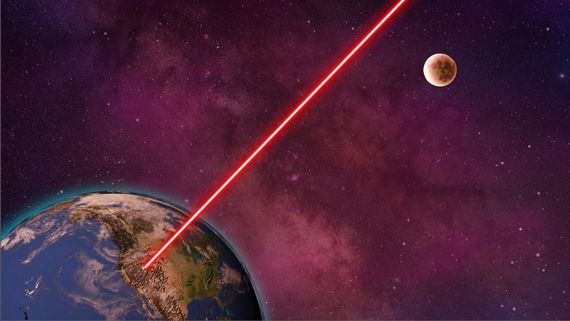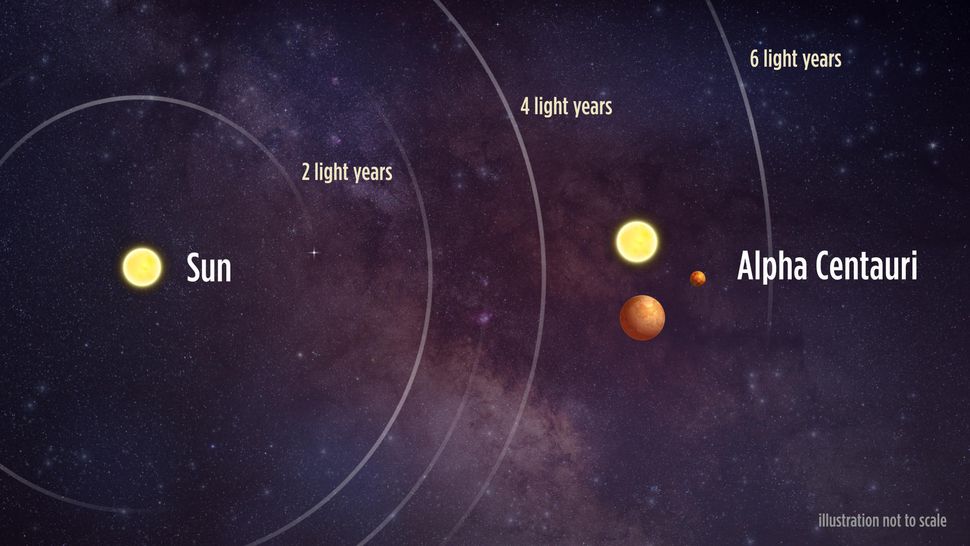Are we alone? Tiny spacecraft will head to Alpha Centauri to seek out out

That is a part of our Road Trip 2018 summer season sequence ‘Taking it to Extremes,’ which seems to be at what occurs when individuals combine on a regular basis tech with insane conditions.
Practically 50 years after a human first set foot on the moon, perhaps it is time for a brand new problem in area. How about discovering out — in our lifetimes — if there’s life on planets orbiting our nearest star neighbors?
That is the purpose of a challenge referred to as Breakthrough Starshot — the brainchild of a Russian billionaire, a former director of NASA‘s Ames Analysis Heart and a bunch of high-level physicists and engineers.
They hope to ship lots of of tiny spacecraft to the Alpha Centauri star system, the place they’re going to examine planets for signs of life. It is a monumental engineering problem that may require enormous leaps in expertise for spacecraft design, propulsion and communication. The try by SpaceX and Tesla Chief Government Elon Musk to get humans to Mars seems to be like a neighborhood stroll by comparability.
But when Breakthrough Starshot succeeds, we might get snapshots of the Alpha Centauri photo voltaic system Four light-years away — roughly the identical as 6,800 journeys to Pluto — 30 to 40 years from now. And perhaps we’ll get a greater thought about simply how uncommon life is within the universe.
‘That is addressing one in every of humanity’s elementary questions: Are we alone?’ says Breakthrough Starshot Government Director S. Pete Worden, who ran the NASA Ames heart in Mountain View, California, for 9 years. ‘If we discover a life-bearing planet orbiting close by stellar programs, that is probably the most elementary discoveries of all time.’
Starshot is not the sort of area mission you are used to. It will not use a mammoth rocket to propel a heavy spacecraft. NASA’s New Horizons interplanetary probe weighed a bit greater than a half ton, for instance. As a substitute, Breakthrough Starshot plans to make use of an enormous Earth-based laser array to shoot a fleet of almost weightless spacecraft touring a lot, a lot quicker. The spacecraft may very well be simply three to 12 ft throughout and weigh as little as a thimbleful of water.
How a lot quicker will they journey? A Starshot spacecraft might transfer at a fifth the pace of sunshine — 134 million miles per hour — to get to the three stars of the Alpha Centauri system in simply over 20 years. As soon as there, they’re going to whiz proper by, snapping photographs furiously, then sending us the information from the far aspect of the journey.
Compared, New Horizons took 9 and a half years to succeed in Pluto.
You might argue the Starshot thought got here from well-known 16th century astronomer Johannes Kepler, who wrote in a letter to fellow brainiac Galileo Galilei, ‘With ships or sails constructed for heavenly breezes, some will enterprise into that nice vastness.’
Starshot’s expertise began to turn into sensible in 1962, shortly after the invention of lasers. That is when physicist Robert Ahead proposed propelling spacecraft by beaming laser gentle at a reflective sail. Lightsails have been examined in our photo voltaic system eight years in the past with Japan’s Ikaros spacecraft, although the solar’s gentle offered solely a modest tenth of a G of thrust.
What makes Starshot a compelling thought now’s many years’ value of labor miniaturizing electronics for computer systems and smartphones. Starshot plans a ‘nanocraft’ whose mass is a couple of single gram, the identical as a paper clip. That may very well be sufficient for the sail, cameras and sensors. These sensors might measure magnetic fields that protect planets from radiation, they usually might detect specific wavelengths of sunshine which will point out the presence of life.

Starshot researchers have a particular vacation spot in thoughts: an precise planet within the comparatively balmy liveable zone round Proxima Centauri, one of many three stars within the Alpha Centauri system. Detailed vacation spot plans will evolve as an precise launch date nears.
The Starshot plan initially referred to as for a tiny bundle of electronics connected to a flat lightsail, maybe 1 to Four meters throughout. Researchers now favor a brand new thought: a comparably sized spherical lightsail studded with electronics.
Consider it as a big pingpong ball with computer systems and cameras pointing in several instructions. The large benefit? The spherical form, coupled with a ‘hole’ laser beam that is stronger towards its outdoors edge, may very well be naturally centered on the beam all through the acceleration.
‘Think about blowing a bit of paper straight up. It is going to fly off the beam except it is completely aligned,’ says Zac Manchester, a Stanford professor and Starshot engineer who’s researched the topic and already launched a 1.4-inch square spacecraft into Earth’s orbit.
‘You must assume exhausting how you can maintain the sail on the beam,’ he says.

Starshot’s laser will get round an enormous downside with the rockets we have been utilizing to discover area. Rockets carry their very own gasoline, in order that they’re actually heavy. Think about you are driving 6,000 miles throughout the USA and again with no fuel stations. Even averaging 30 miles per gallon, you’d want a 200-gallon tank that’ll saddle your automobile with greater than 1,200 kilos of gasoline. No extra jackrabbit begins when the sunshine turns inexperienced.
Starshot dispenses with all that as a result of a mothership orbiting Earth would launch the nanocraft. The laser hitting the crafts’ lightsails will then ship them rushing towards Alpha Centauri.
‘The fantastic thing about utilizing a photon beam from Earth is the spacecraft has no gasoline in any respect,’ says George Sowers, a Colorado Faculty of Mines professor who beforehand was chief engineer for the Atlas V rocket that launched New Horizons. A laser launch frees you from ‘the tyranny of the rocket equation,’ he says.
The Starshot laser system, concentrating gargantuan quantities of sunshine onto a tiny craft for only a few minutes, might speed up the nanocraft with a 60,000-G drive. (The Earth pulls you to the bottom with a drive of 1G.) That is the identical as a bullet shot from a gun, however protracted for minutes as a substitute of a cut up second. Afterward, the nanocraft could be six instances the space from the Earth to the moon and touring far quicker than the rest people have ever constructed. For those who might fly a airplane at that clip, you’d circle the Earth’s equator in two-thirds of a second.
The challenge has begun funding researchers to hone physics prospects into engineering realities. Each Worden and Avi Loeb, chief of Harvard’s Astronomy Division and the Breakthrough Starshot Advisory Committee, level to a few huge issues the workforce wants to resolve earlier than any nanocraft can wing their method by area.
The primary is constructing an array of lasers which are highly effective sufficient, low-cost sufficient and intimately interlinked so hundreds of thousands can act like a single laser. The mixed laser energy must be one thing near 100 gigawatts, the output of a couple of 100 nuclear energy crops, although just for a brief burst.
Thankfully, lasers have gotten extra economical. ‘Laser energy is doubling each 20 months and the fee is halving each 34 months,’ Loeb says. Even so, you possibly can anticipate the laser array to value one thing like $10 billion, Loeb says.

The second problem is constructing a lightsail materials that will not vanish right into a puff of ash when hit by that humongous laser beam. ‘Even when one-ten-thousandth of the laser vitality is absorbed, it will burn,’ Loeb says.
Third is discovering a method for the nanocraft to ship a message again to Earth with a low-power laser. Starshot researchers imagine the identical laser array that accelerates the nanocraft can work in reverse to obtain a returning laser sign — a tough feat for the reason that nanocraft’s sign shall be weak after touring such an unlimited distance.
Starshot this yr started funding analysis initiatives to resolve the challenges, Manchester mentioned. It is awarded its first grants for high-powered laser analysis, and now it is requested for supplies science initiatives on crafting gentle sail that is extraordinarily gentle and intensely reflective.
Manchester himself has some expertise in excessive spacecraft. He is the chief of a challenge referred to as KickSat that is launched into Earth orbit one batch of teensy satellites — they seem like bare circuit boards concerning the measurement of a big postage stamp — and plans one other launch of latest KickSat-2 fashions this November.
‘The truth that we constructed 4-gram satellites and flew them in area — that lends some credibility to the [Starshot] story,’ Manchester mentioned. ‘It is a stepping stone.’
KickSat-2 satellites value simply $20 apiece. Starshot’s nanocraft will not be that low-cost, however they’re going to nonetheless be inexpensive sufficient that we are able to launch them in droves from a single mothership. That’ll give us numerous probabilities to listen to messages.
‘After getting the infrastructure, you possibly can launch one per day,’ Loeb says. ‘There may very well be lots of or hundreds of them despatched in several instructions.’
These are simply the three largest hurdles. The Starshot workforce retains tabs on greater than two dozen other challenges, too. One is interstellar mud.
Operating into even a single hydrogen atom is an enormous deal once you’re tooling alongside at a fifth of the pace of sunshine. ‘Consider it as a tiny nuclear bomb hitting you,’ Loeb says.
The nanocraft might truly harness that vitality by exploiting the temperature distinction between the entrance of the spacecraft, the place the mud hits, and the cooler bottom. Spacecraft and gas pipeline sensors already use this expertise, referred to as a thermoelectric generator.
Breakthrough Starshot additionally has to wrestle with the political problems of working a laser highly effective sufficient to vaporize a communications satellite tv for pc. Worden expects a global coalition could be in management, with any nation capable of veto a laser shot that might hurt plane and satellites.
The researchers are additionally contemplating the chance that Starshot might truly announce our existence to doubtlessly hostile aliens.
‘I began life [as] a army officer. Normally earlier than you ship a mission, you attempt to determine forward what’s there,’ says Worden, beforehand a brigadier normal within the US Air Power who labored on area and missile applications.
Nonetheless, even superior aliens would wrestle to catch a tiny nanocraft blasting previous at a fifth the pace of sunshine. People definitely could not deal with any alien nanocraft despatched right here. ‘These may very well be flying by the photo voltaic system on a regular basis and we would by no means see them,’ Worden says.
Planning an effort that’ll value billions of {dollars} and take many years to finish may appear to be a stretch. The US has struggled to match the large, sustained effort of the Manhattan Challenge to construct the primary atomic weapons or the Apollo program to ship people to the moon. However there have been different large-scale successes.

The Large Hadron Collider (LHC), an unlimited particle accelerator close to Geneva however run by scientists from across the globe, found the previously elusive Higgs boson in 2012, thereby advancing our data of essentially the most elementary physics. Building on the world’s largest and strongest particle collider started in 1998.
And in 2016, the Laser Interferometer Gravitational-wave Observatory (LIGO) confirmed Albert Einstein’s 1916 prediction of gravitational waves — revealing new science about colliding black holes and neutron stars.
And NASA’s Voyager 1 and a couple of probes, launched in 1977, are anticipated to maintain gathering scientific information by a minimum of 2025.
Starshot has an attention-grabbing distinction from a few of these different initiatives: personal funding. This system’s first $100 million comes from Yuri Milner, a Russian who studied theoretical physics earlier than turning into an investor who did nicely by plowing cash into firms like Fb, Twitter, Airbnb, Spotify and Alibaba. That will assist Starshot keep away from the destiny of the Superconducting Supercollider, a particle accelerator which may have discovered the Higgs boson if Congress hadn’t famously pulled funding in 1993.
Worden envisions authorities assist from around the globe to construct the total Starshot program, however 21st century philanthropy might nonetheless be essential. In spite of everything, Fb Chief Government Mark Zuckerberg is on the Starshot board, Microsoft co-founder Bill Gates is spending his fortune fighting diseases, Google co-founder Sergey Brin helps sponsor Breakthrough’s $three million annual prizes to scientists and mathematicians, and Amazon CEO Jeff Bezos is plowing hundreds of thousands into his Blue Origin rocket startup.
Identical to the area race within the 1960s drove US expertise, Starshot might ship extra than simply snapshots from Alpha Centauri.
Starshot’s researchers are notably struck by the thought of utilizing the laser to propel heavier objects shorter distances.

‘That laser system would completely change the sport for photo voltaic system transportation and allow us to get to Mars tremendous rapidly and recurrently,’ Stanford’s Manchester says.
Governments is likely to be happier coughing up billions of {dollars} for Starshot’s laser if it may very well be used to push asteroids off collision programs with Earth, too. ‘If the dinosaurs had an enormous laser, perhaps they’d nonetheless be right here,’ Worden says.
It is years too quickly for bean counters to plan any returns on funding, but when Starshot overcomes its monumental challenges, it will powerfully increase humanity’s enthusiasm for area, Sowers says.
‘We might get one thing again that will actually encourage individuals,’ he says. ‘It will be incalculable.’
